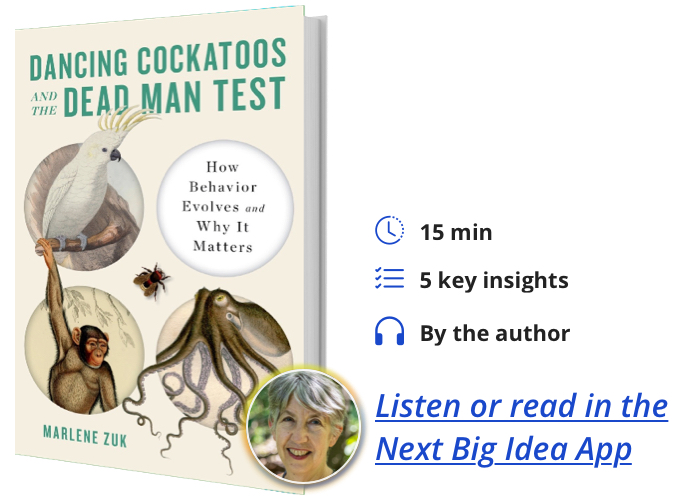Marlene Zuk is an evolutionary biologist and a professor of biology at the University of Minnesota, where she researches animal behavior.
Below, Marlene shares 5 key insights from her new book, Dancing Cockatoos and the Dead Man Test: How Behavior Evolves and Why it Matters. Listen to the audio version—read by Marlene herself—in the Next Big Idea App.
1. The nature-nurture controversy is a zombie idea.
When people think about behavior in either humans or animals, they often want to know if that behavior is genetic or whether it’s learned. That’s especially true when headlines are full of declarations like “Our politics are in our DNA.”
This is the old nature-nurture debate. Traits as complex as intelligence or aggression have to be affected by both genes and the environment. And yet, we keep resurrecting this notion of it being nature or nurture. The nature-nurture controversy has become a zombie idea that keeps springing back to life but deserves to die once and for all.
The problem is that if people genuinely believe that, for example, men will always grow up with dominating tendencies because it’s in their genes, then interventions to prevent aggression are worthless. In reality, it’s the interplay, the entanglement, between genes and environment that’s important.
We can illustrate that with a human disorder that’s often called a genetic disease, phenylketonuria (PKU). It’s screened for in infants with a heel prick at birth. Babies with two copies of a defective gene cannot properly metabolize the amino acid phenylalanine, which then builds up in the bloodstream, leading to severe intellectual disability. Seems obviously genetic, right? Nope—it turns out that if these babies are given a special diet, then they develop normally, so one could argue that the disease is environmental. The interaction of genes and the environ-ment is what matters. The outcome of whether the child grows up intellectually disabled or not depends on which diet they receive only if they have the defective genes.
“It’s the interplay, the entanglement, between genes and environment that’s important.”
A greater cause cannot be ascribed to genes or environment. And that’s true for all traits. Next time you read that there’s a gene “for” a behavior, whether it’s dog ownership or intelligence, think zombie.
2. Having a small brain doesn’t mean you are dumb.
Many people have tried connecting brain size and intelligence, with the assumption that a big brain is a prerequisite for complex or flexible behavior. But few have drawn this comparison out to its logical conclusion: are there animals that are so tiny that they are almost too stupid to live or do complicated tasks?
To figure this out, a scientist named William Eberhard studied extremely small spiders (including one kind that weighs less than a milligram) or about as much as an inch of sewing thread. Yet the spiders still produce orb webs, the silky wheel that entraps their even tinier prey. Eberhard measured whether the difficult process of weaving and adjusting a web was more of a challenge to the minuscule spiders than to three other kinds of spiders that weighed anywhere from 10 to 10,000 times more. The small spiders are just as capable as larger ones.
How do they manage that? Some tiny species cram brain tissue into places where it is not usually found, like into their legs, giving, as Eberhard and his colleague Bill Wcislo say, “new meaning to the phrase thinking on your feet. This begs the question of how little tissue is required to run an animal at all, since nerve cells are limited by the laws of physics in how small they can become. Recent work suggests that the tiny spiders reduce neuron size and increase their relative brain size, so they have essentially equal numbers of neurons compared with larger orb weavers.
All nervous systems, and all brains, are success stories; you can’t draw conclusions simply based on size. This should make us wary of generalizing intelligence, and what is meant by intelligence—especially in insects. Insects have surprisingly large behavioral repertoires given their small brains, with flexibility that rivals that of some vertebrates. Maybe the question should be not how insects do so much with tiny brains, but why vertebrates bother with big ones?
3. Dogs are not exceptional.
Dr. Stephen Lea is a brave man. An emeritus professor of psychology at the University of Exeter in England, he published a paper with Britta Osthaus titled, “In what sense are dogs special?” The conclusion was that they aren’t.
The reception to their work was not appreciative. “Your Dog Is Probably Dumber Than You Think, a New Study Says,” smirked a typical headline from Time magazine. Lea tried to pacify the dog people in an interview by saying, “Dog cognition may not be exceptional, but dogs are certainly exceptional cognitive research subjects.” No one seemed placated.
“All nervous systems, and all brains, are success stories.”
The study didn’t show that dogs were stupid. It asked whether they were smarter than you would expect. To answer this, Lea and Osthaus picked three groups for comparison. First, they looked at other species that are related to dogs evolutionarily—members of the group Carnivora, meaning meat-eaters, including African wild dogs and cats. Then, they considered dogs as social hunters, alongside dolphins and chimpanzees. Finally, they examined horses and domestic pigeons, both of which are domesticated like dogs and which share characteristics like being subject to training.
The result was that dogs do well at discriminating complex visual patterns, like telling human faces apart, but so do chimps and pigeons. Dogs are good at smells, but they are bested by pigs, which can even distinguish between the odors of familiar and unfamiliar people. Dogs are not especially skilled at what Lea and Osthaus term “physical cognition”—recognizing the consequences of manipulating objects like strings attached to food. Despite the heartwarming nature of movies like Homeward Bound, dogs aren’t particularly good at navigating over long distances.
But it doesn’t make sense to pick on an animal, no matter how beloved, and rank it according to a scale that only works in a single dimension or on human-centric traits. For the most part, nonhuman animals are not considered smart unless they’ve passed a test designed by humans, like making a tool or recognizing themselves in a mirror. But dogs are good at things that make sense for dogs, not things that make sense for humans. Though an unsatisfying answer, it makes sense from an evolutionary standpoint.
4. Animals can treat their diseases.
Early humans used medicine and treated injuries such as fractures, but where did their knowledge come from? Do animals help themselves feel better when they are sick?
Yes. Chimpanzees in Africa eat a variety of plants, but some individuals have been seen to select the young shoots of one particular plant, stripping the stems of their bark, and chewing the bitter pith and juice. These individuals often seemed sick with diarrhea, weight loss, and a lack of energy. Researchers found that the use of the plant was associated with a drop in intestinal parasites. Chimps will also swallow entire leaves from a different plant whole (without chewing) and here the leaves had tiny hairs that seem to scrape worms from the gut and allow them to be expelled.
This kind of behavior doesn’t necessarily require a sophisticated level of cognition. Animals have many ways of changing their behavior to deal with infection, and not all of the animals that do so are those we consider “smart,” as we do apes. For instance, goats supposedly eat anything, from tin cans to laundry off the line, but they are remarkably sensitive foragers. If infected with roundworms, they will eat more of a shrub containing a chemical that fights the worms.
“Animals have many ways of changing their behavior to deal with infection, and not all of the animals that do so are those we consider ‘smart,’ as we do apes.”
Many birds’ nests are plagued by lice, fleas, and other parasites. These suck blood from the young birds and can lead to slower growth or even death. The parent birds can’t physically remove the pests, but some species place aromatic leaves inside the nest. The plants act as a natural fumigant, reducing the number of fleas and other external parasites. House finches have even adapted to urban environments by weaving fibers from cigarette butts into their nests, also for its fumigant effect. The butts contain nicotine, which is often used as an insecticide, and it keeps fleas and lice away. The use of tobacco, however, carries a cost: in nests with nicotine, both the nestlings and their parents showed signs of DNA damage.
5. Animals get mentally ill too.
Darwin thought that insanity in animals demonstrated how all living things are related, so he thought they did get mentally ill. On the other hand, some scientists think that animals can serve as models for us to understand mental illness, but don’t get the disorders themselves. Yet others think animals are only mentally ill when they are mistreated by humans.
I agree with Darwin, and one of the best places to see the continuity of mental disorders in humans and animals is in Obsessive Compulsive Disorder, OCD. People have noticed for many years that some characteristics of OCD are also seen in animals, particularly dogs. The disorder means doing normal behaviors—hand-washing, turning in circles before lying down—too much. In dogs, we call it CCD, Canine Compulsive Disorder, because we can’t know what dogs are or aren’t obsessing over.
A scientist named Elinor Karlsson and her team have identified genes that affect a dog’s risk of showing the disorder. These genes govern the way nerve cells communicate. But knowing a dog’s genetic makeup won’t tell you definitively whether or not they will exhibit the disorder. Dogs, like humans, inherit one copy of any particular gene from their mother and one copy from their father, so both can be the same or they can have one normal and one abnormal gene. Of the dogs with two normal copies, 10% have CCD anyway; of the ones with one copy of each type, 25% have it; and of the dogs with two abnormal copies, 60% show CCD, but not all of them. Knowing the dog’s genetic profile doesn’t tell you for sure whether the dog has the disorder.
This shows us two things. First, entanglement of genes and the environment because the gene doesn’t cause the disorder unless the environment favors it. Second, mental disorders can illustrate the common evolutionary roots in our brains and bodies that give rise to amazingly different behaviors.
To listen to the audio version read by author Marlene Zuk, download the Next Big Idea App today:































